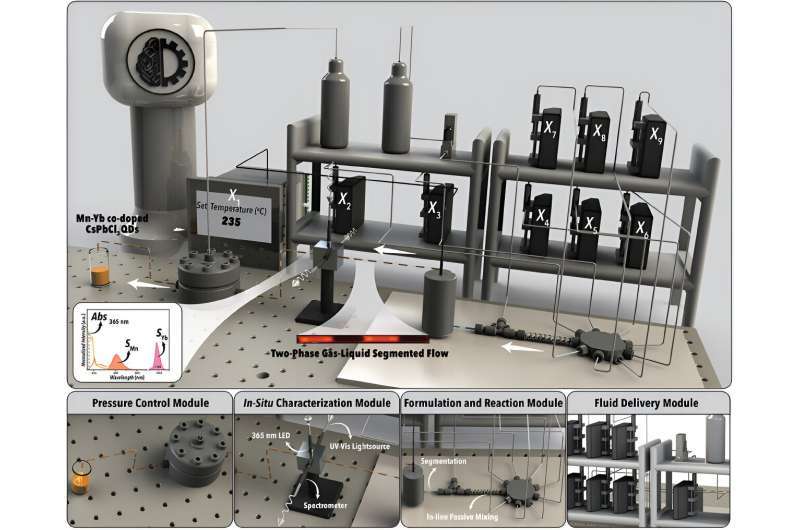This article has been reviewed according to Science X's editorial process and policies. Editors have highlighted the following attributes while ensuring the content's credibility:
fact-checked
peer-reviewed publication
trusted source
proofread
Autonomous lab discovers best-in-class quantum dot in hours. It would have taken humans years

It can take years of focused laboratory work to determine how to make the highest quality materials for use in electronic and photonic devices. Researchers have now developed an autonomous system that can identify how to synthesize "best-in-class" materials for specific applications in hours or days.
The new system, called SmartDope, was developed to address a longstanding challenge regarding enhancing properties of materials called perovskite quantum dots via "doping."
"These doped quantum dots are semiconductor nanocrystals that you have introduced specific impurities to in a targeted way, which alters their optical and physicochemical properties," explains Milad Abolhasani, an associate professor of chemical engineering at North Carolina State University and corresponding author of the paper "Smart Dope: A Self-Driving Fluidic Lab for Accelerated Development of Doped Perovskite Quantum Dots," published open access in the journal Advanced Energy Materials.
"These particular quantum dots are of interest because they hold promise for next generation photovoltaic devices and other photonic and optoelectronic devices," Abolhasani says. "For example, they could be used to improve the efficiency of solar cells, because they can absorb wavelengths of UV light that solar cells don't absorb efficiently and convert them into wavelengths of light that solar cells are very efficient at converting into electricity."
However, while these materials are very promising, there's been a challenge in developing ways to synthesize quantum dots of the highest possible quality in order to maximize their efficiency at converting UV light into the desired wavelengths of light.
"We had a simple question," Abolhasani says. "What's the best possible doped quantum dot for this application? But answering that question using conventional techniques could take 10 years. So, we developed an autonomous lab that allows us to answer that question in hours."
The SmartDope system is a "self-driving" lab. To begin, the researchers tell SmartDope which precursor chemicals to work with and give it a designated goal. The goal in this study was to find the doped perovskite quantum dot with the highest "quantum yield," or the highest ratio of photons the quantum dot emits (as infrared or visible wavelengths of light) relative to the photons it absorbs (via UV light).
Once it has received that initial information, SmartDope begins running experiments autonomously. The experiments are conducted in a continuous flow reactor that uses extremely small amounts of chemicals to conduct quantum dot synthesis experiments rapidly as the precursors flow through the system and react with each other.
For each experiment, SmartDope manipulates a suite of variables, such as: the relative amounts of each precursor material; the temperature at which it mixes those precursors; and the amount of reaction time given whenever new precursors are added. SmartDope also characterizes the optical properties of the quantum dots produced by each experiment automatically as they leave the flow reactor.
"As SmartDope collects data on each of its experiments, it uses machine learning to update its understanding of the doped quantum dot synthesis chemistry and inform which experiment to run next, with the goal of making the best quantum dot possible," Abolhasani says. "The process of automated quantum dot synthesis in a flow reactor, characterization, updating the machine learning model, and next-experiment selection is called closed-loop operation."
So, how well does SmartDope work?
"The previous record for quantum yield in this class of doped quantum dots was 130%—meaning the quantum dot emitted 1.3 photons for every photon it absorbed," Abolhasani says. "Within one day of running SmartDope, we identified a route for synthesizing doped quantum dots that produced a quantum yield of 158%. That's a significant advance, which would take years to find using traditional experimental techniques. We found a best-in-class solution for this material in one day.
"This work showcases the power of self-driving labs using flow reactors to rapidly find solutions in chemical and material sciences," Abolhasani says. "We're currently working on some exciting ways to move this work forward and are also open to working with industry partners."
More information: Fazel Bateni et al, Smart Dope: A Self‐Driving Fluidic Lab for Accelerated Development of Doped Perovskite Quantum Dots, Advanced Energy Materials (2023). DOI: 10.1002/aenm.202302303
Journal information: Advanced Energy Materials
Provided by North Carolina State University





















